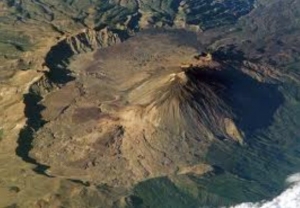Data reduction and inversion
During the seismic unrest at the central volcanic complex (CVC) on Tenerife bulk gravity increase was recorded across a network at the CVC between May 2004 and July 2005 [5]. Here we aim at interpreting the gravity signal in terms of multiple sources using a non-linear inversion based on line segments approximation. The gravity changes were corrected for water table changes [5] and kriging-extrapolated onto an equidistant grid with a step of 500 m (Fig. 1). A trend, determined as a 2D harmonic function within the survey area, coinciding with the observed data on the boundary [6] was removed, in order to minimize the edge effects and truncation errors. Residual gravity changes after the removal of trend are shown in Fig. 2. Horizontal coordinates in the figures are UTM easting and northing, gravity is given in mGals (1mGal = 10-5 m/s2). The residual gravity changes (Fig. 2) were then best-fitted with the gravitational effect of line segments, each being defined by seven sought parameter, twice the triplet of coordinates and a line density [7]. These parameters were determined by minimizing residuals in L2 norm by means of non-linear minimization procedure, using the gradient method of [4]. The line segments represent sources of temporal mass changes. With 3 line segments we achieve a fit of 3 μGal rms. Two of our segments, located to the NW of the Pico Viejo–Pico Teide (PV–PT) complex correlate with the NW seismogenic zone of [3].
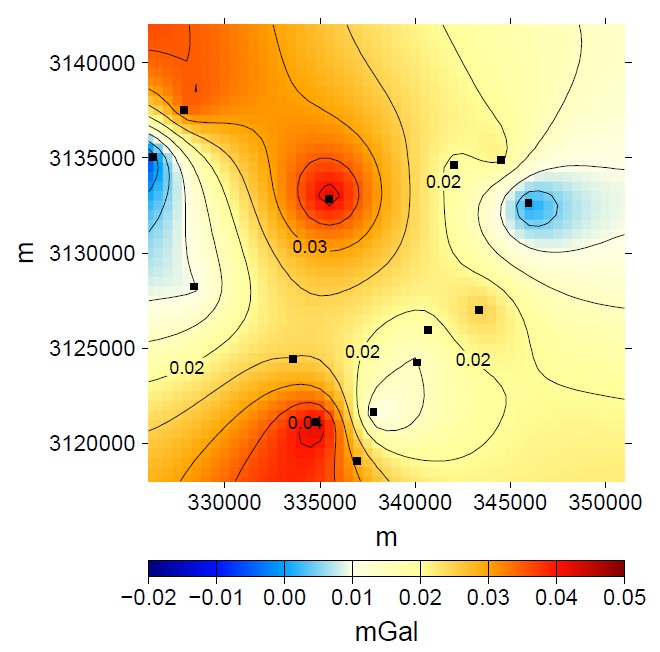 |
 |
|
Fig. 1. Observed gravity changes (mGal) |
Fig. 2. Residual gravity changes (mGal) |
They are located at depths 0–2 km b.s.l. The shallower SW line segment lies at the SW section of the caldera rim, and correlates with the SW seismogenic zone of [3].
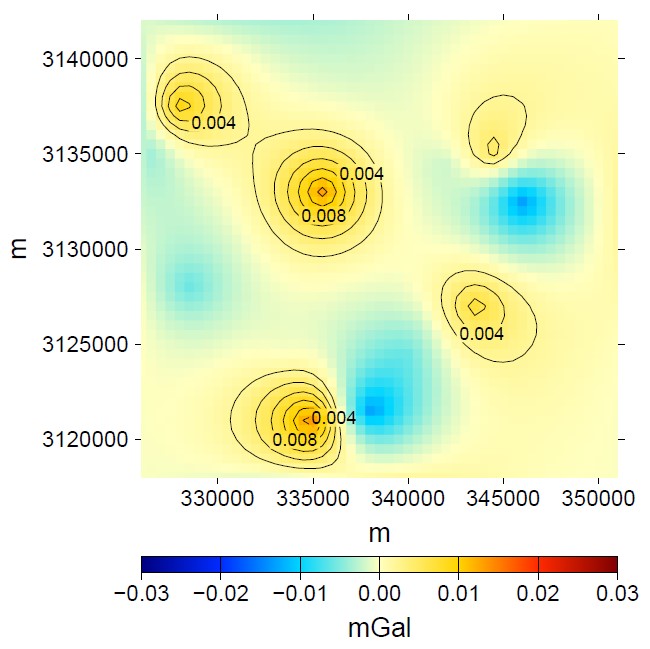 |
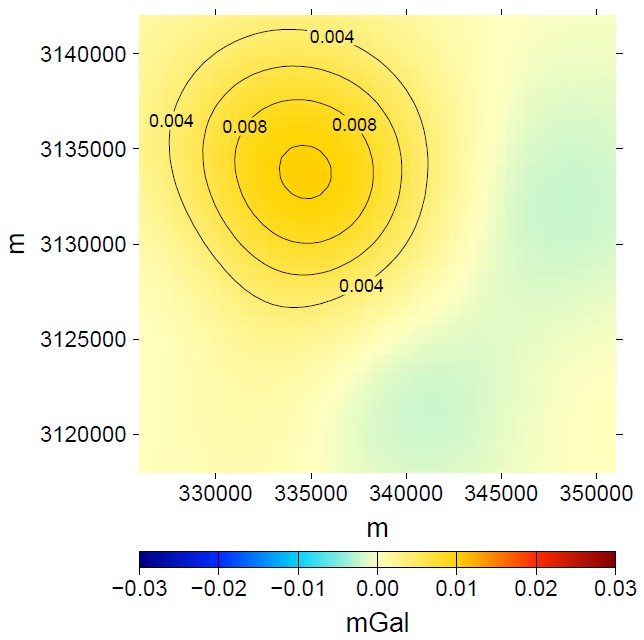 |
|
Fig. 3 Shallow field (mGal) |
Fig. 4. Deep field (mGal) |
We suspect that these line segments are composite sources representing shallower hydrothermal fluids and deeper magma injection. To test this hypothesis, we separate these composite sources into shallow and deep sources as follows. We decompose the residual gravity changes (fig. 2) into a “shallow field” generated by presumed shallow sources and a “deep field” generated by deep sources. The division level of 4 km below sea lvel (b.s.l.) was chosen to match roughly the upper boundary of the two seismogenic zones of [3]. The decomposition procedure, based on stepwise upward, downward and upward sequential harmonic continuations, is described in [6]. The shallow and deep fields resulting from the decomposition are presented in figures 3 and 4, respectively. Again, both the shallow and deep fields are inverted in terms of their respective line segments. The inversion results in 3 shallow segments and 2 deep short and connected segments (one bent segment), see Fig. 5. The shallow and deep fields are approximated with rms of 2.3 and 0.7 mGal, respectively.
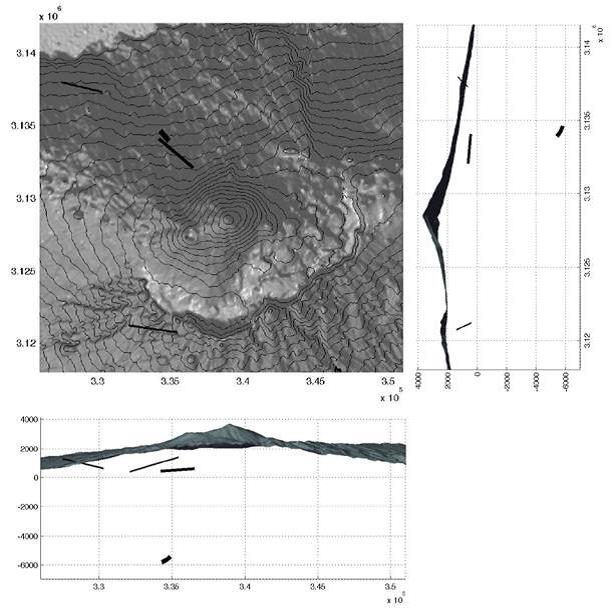
Fig. 5. The three shallow line segments and the short deep bent line segment.
Interpretation of inversion results and conclusion
Although the depth of the two NW segments found by inversion prior to signal decomposition matches the petrologically determined depth of phonolitic magma reservoirs beneath the PV-PT complex ([1] and [2]), we do not interpret them as magmatic sources. We suggest that they represent a superposition of shallower hydrothermal water and deeper magma injection triggering the rise of the fluids. This is why we carried on with their decomposition into shallow and deep sources. Upon decomposition the inversion yields shallow and deep line segments. Due to the spatial distribution of the shallow segments and the position of the deep one, as well as their spatial correlation with the seismogenic zones of [3], we interpret the shallow segments as sources of hydrothermal fluids, while the short deep segment as a magma injection at a depth of about 6 km, within the NW zone of VT events swarm identified by [3]. This hybrid nature of the observed unrest is best explained by the migration of hydrothermal fluids as a result of magma injection. Our inversion results and interpretation appear to be in fair agreement with the model of the tree-like magma intrusion proposed by [3].
References
1. Ablay, G.J., Martí J.: Stratigraphy, structure, and volcanic evolution of the Pico Teide – Pico Viejo formation, Tenerife, Canary Islands, J. Volcanol. Geotherm. Res., 103(1–4), 175–208 (2000)
2. Andújar, J., Costa, F., Martí, J.: Magma storage conditions of the last eruption of Teide volcano (Canary Islands, Spain). Bulletin of Volcanology 72, 381–395 (2010)
3. Cerdeña D.I., del Fresno C., Rivera L.: New insight on the increasing seismicity during Tenerife's 2004 volcanic reactivation. J. Volcanol. Geotherm. Res. 206, 15–29 (2011)
4. Fletcher R., Powell, M.J.D.: A rapidly convergent descent method for minimization. The Computer Journal 6(2): 163–168 (1963)
5. Gottsmann, J., Wooller, L., Martí, J., Fernández, J., Camacho, A.G., Gonzalez, P.J., Garcia, A., Rymer, H.: New evidence for the reawakening of Teide volcano. Geophys. Res. Lett., 33, L20311 (2006)
6. Prutkin I., Vajda P., Tenzer R., Bielik, M.: 3D inversion of gravity data by separation of sources and the method of local corrections: Kolarovo gravity high case study. Journal of Apllied Geophysics 75(3), 472–478 (2011)
7. Vajda P., Prutkin I., Tenzer R., Jentzsch G.: Inversion of temporal gravity changes by the method of local corrections: A case study from Mayon volcano, Philippines. J. Volcanol. Geotherm. Res. Vol. 241–242, 13–20 (2012)

